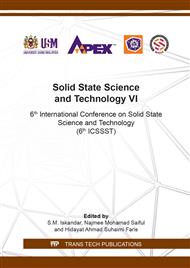p.280
p.286
p.292
p.301
p.307
p.314
p.323
p.329
p.336
Magnetic Cooperative Phenomenon with Unpaired sp-Electrons System by MBE Low-Temperature Growth
Abstract:
We present a new possibility of crystal growth as synthesis of materials containing high concentrations of unpaired sp electrons by growth of Be doped Gallium Arsenides at low temperatures of 200-3000C using Molecular Beam Epitaxy (MBE) and investigate a possibility of applications of magnetotransport properties based on these unpaired sp-electrons to spintronics devices.The present study using high concentration of unpaired sp-electrons by the growth of Beryllium-doped GaAs layers at low temperatures resulted in a cooperative transition of localized spins at low temperature and also affected the mechasnism of tranport properties of the sample from hopping conduction to valence band conduction.This attempts will give rise to a possibility of adding new functions to existing electronic devices.
Info:
Periodical:
Pages:
336-341
Citation:
Online since:
April 2019
Authors:
Price:
Сopyright:
© 2019 Trans Tech Publications Ltd. All Rights Reserved
Share:
Citation:


